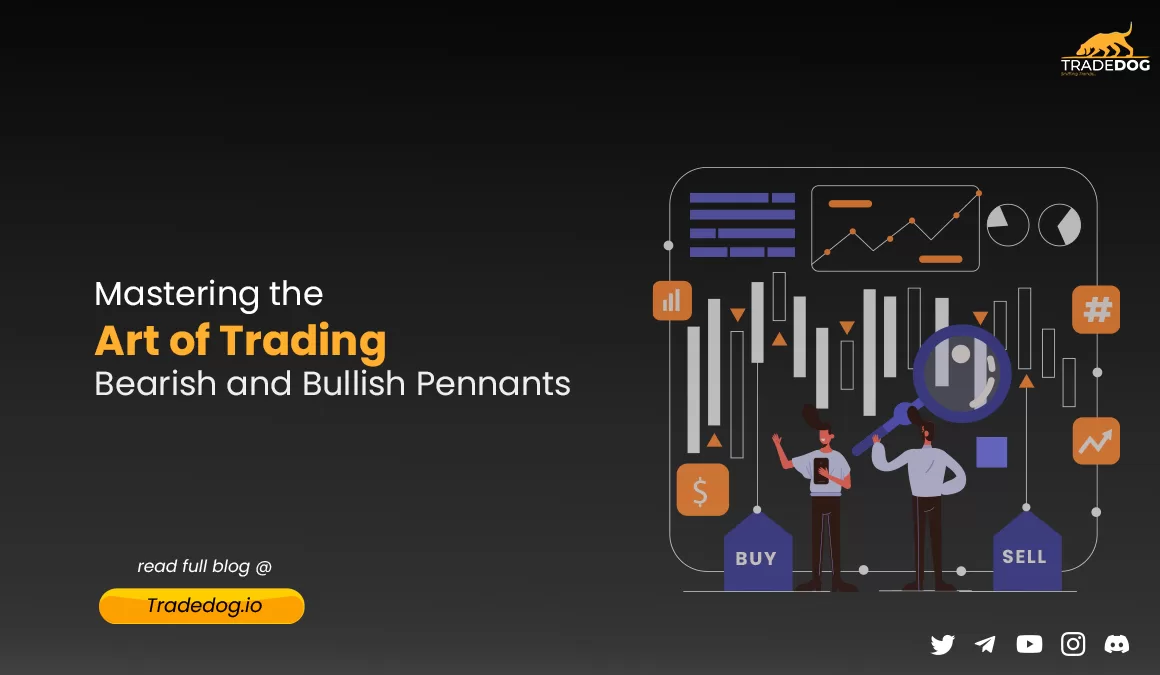Quick Links
Enter the world of trading where investors aim to predict the market’s direction and make profits. Learning how to master bearish and bullish pennants is key to this pursuit. These patterns, formed by price movements, indicate if the current trend is continuing and whether it is bullish or bearish. Trading pennants can provide traders with a significant edge in the market, making them game-changer. This article will explore what bearish and bullish pennant patterns are, their significance, and how to trade them effectively. Let’s begin by understanding the concepts of bullish and bearish pennants before moving on to the importance of trading pennants and mastering the art of trading them.
Understanding Pennants
One of the critical concepts in trading is understanding pennants. Pennants are technical chart patterns that signal a continuation of a trend in the market. These patterns form after a significant price movement and resemble a triangular shape, often resembling a flag, which is where the name “pennant” originates. In this article, we’ll delve deeper into understanding pennants and how they work.
Definition of Pennants
Pennants are technical chart patterns that form after a sharp price movement in the market. They are triangular-shaped patterns that represent a period of consolidation before the market resumes its previous trend. There are two types of pennants – bearish pennants and bullish pennants.
Types of Pennants
Bearish pennant pattern forms after a price decline in the market. They signal a continuation of the downward trend. Bullish pennant patterns, on the other hand, form after a price increase and signal a continuation of the upward trend.
Differences Between Pennants and Other Chart Patterns
Pennants are often confused with other chart patterns such as triangles or flags. However, there are significant differences between these patterns. Triangles have a broader shape and do not indicate a continuation of the trend like pennants do. Flags have a rectangular shape and signal a correction in the market rather than a continuation of the trend.
Identifying Bullish Pennants
Are you a trader trying to understand bull pennants? Look no further! Here, we’ll discuss the key characteristics of bullish pennants and how to identify them.
Characteristics of Bullish Pennants
These pennants are a bullish continuation pattern that occurs in an uptrend. They are characterized by a small symmetrical triangle pattern that forms after a sharp price increase. The pattern is formed by two converging trend lines, with decreasing volume during the consolidation phase.
How to Identify Bullish Pennants
To identify a bullish pennant, traders should look for a sharp increase in price, followed by a small triangle-shaped pattern. The triangle should be formed by two converging trend lines, and there should be a decrease in volume during the consolidation period.
Trading Strategies for Bearish Pennants
Bearish pennants are a popular chart pattern among traders who wish to profit from a downtrend in the market. Here are some trading strategies that can be employed to trade bearish pennants.
Breakdown Strategy for Bearish Pennants
The breakdown strategy for bearish pennants involves short-selling the asset once the price breaks below the lower trend line of the pattern. This strategy is based on the assumption that the downtrend will continue after a negative breakout from the pattern. Traders should set a stop loss above the pattern’s high to limit potential losses.
Retracement Strategy for Bearish Pennants
The retracement strategy for bearish pennants involves waiting for a retracement to the upper trend line before entering a short position. Traders should wait for the price to test the upper trend line before entering the trade, and then short-sell the asset once the price breaks below the lower trend line.
Entry and Exit Points for Bearish Pennants
The entry point for bearish pennants is at the break of the upper trend line, while the exit point is determined by the trader’s risk tolerance and profit target. Traders can also use technical indicators such as the Moving Average Convergence Divergence (MACD) and Relative Strength Index (RSI) to help identify potential entry and exit points.
Trading bearish pennants requires careful analysis and strategy. Traders can employ a breakdown strategy or a retracement strategy, and should always set stop-loss orders to limit potential losses. By identifying entry and exit points and using technical indicators, traders can potentially profit from bearish pennants in the market.
Tips for Trading Pennants
Trading pennants can be a highly effective way for traders to generate profit from the continuation of a trend in the market. However, like any trading strategy, it is important to have a solid approach and mindset to succeed. Here are some tips for trading pennants.
Risk Management
Risk management is crucial when trading pennants, as it helps to protect your capital and limit potential losses. Traders should set stop-loss orders and never risk more than they can afford to lose on any given trade.
Position Sizing
Position sizing is also important when trading pennants. Traders should determine the appropriate position size based on their risk tolerance and the size of their trading account. It is important to never over-leverage or put too much capital at risk on any given trade.
Trading Discipline
Trading discipline is essential for success when trading pennants. Traders should have a solid trading plan in place and stick to it, regardless of market conditions or emotions. It is also important to avoid impulsive trading decisions and to remain patient when waiting for the right setup.
Importance of Patience
Patience is a key component of successful trading, especially when trading pennants. Traders should wait for the right setup to present itself and not force trades based on emotions or a desire to make quick profits.
Technical Analysis Tools for Trading Pennants
Technical analysis is an essential aspect of trading pennants, as it provides traders with the tools and indicators needed to identify potential trading opportunities. There are several technical analysis tools that can be used for trading pennants, including moving averages, the relative strength index (RSI), Fibonacci retracement, and Bollinger Bands.
Moving Averages
Moving averages are a commonly used technical analysis tool in trading pennants. They are used to identify the overall direction of the trend and to signal potential buy or sell opportunities. Traders often use a combination of different moving averages, such as the 50-day and 200-day moving averages, to confirm trend direction and to identify potential entry and exit points.
Relative Strength Index (RSI)
The relative strength index (RSI) is another popular technical analysis tool for trading pennants. It is used to measure the strength of a trend and to identify potential overbought or oversold conditions. Traders typically use the RSI in conjunction with other technical indicators to confirm trend direction and to identify potential entry and exit points.
Fibonacci Retracement
Fibonacci retracement is a technical analysis tool that is used to identify potential support and resistance levels in a market. Traders use Fibonacci retracement levels to identify potential entry and exit points and to confirm trend direction. The most commonly used Fibonacci retracement levels are 38.2%, 50%, and 61.8%.
Bollinger Bands
Bollinger Bands are a technical analysis tool that is used to identify potential overbought or oversold conditions in a market. They are made up of three lines: a middle line that represents the 20-day moving average, and an upper and lower line that represents two standard deviations from the middle line. Traders use Bollinger Bands to identify potential entry and exit points and to confirm trend direction.
In conclusion, technical analysis tools are essential for trading pennants. Moving averages, the RSI, Fibonacci retracement, and Bollinger Bands are all useful tools for identifying potential trading opportunities and confirming trend direction. Traders should consider using a combination of these tools to maximize their chances of success when trading pennants.
Conclusion
To summarize, acquiring the expertise to trade bearish and bullish pennants can prove to be a highly valuable asset in the realm of cryptocurrency trading. By detecting these formations and comprehending how to leverage them to your advantage, you have the potential to uncover lucrative trading prospects.
It’s essential to keep in mind that undertaking thorough research, gaining a robust understanding of the market, and acknowledging the fact that no trading tactic is entirely reliable are critical factors to consider. Start trading pennants today and identify where this knowledge can lead you in your trading expedition.
FAQs
What is the success rate of trading pennants?
Trading pennants’ success rates can vary based on different factors such as market conditions, a trader’s expertise, and managing risks. While there’s no fixed success rate, pennants are generally considered a dependable continuation pattern offering a higher chance of success when traded accurately. However, it’s essential to note that past performance doesn’t guarantee future results, and traders must always practice risk management.
How long do pennants usually last?
The duration of pennant formation usually lasts a few weeks to a few months, contingent on the market conditions and the trend’s strength. Typically, the more extended the pennant formation’s duration, the stronger the continuation chart pattern is viewed.
What are the best markets for trading pennants?
Pennants can be traded across various markets, including stocks, forex, and commodities. Nevertheless, the most suitable markets for trading pennants are those with high volatility and liquidity. A few examples of such markets include popular tech stocks, major currency pairs, and energy commodities.
Can pennants be used with other trading strategies?
Absolutely, traders can use pennants along with other trading strategies to enhance their probability of success. For instance, traders can use technical indicators such as moving averages or oscillators to identify potential entry and exit points or confirm the breakout from the pennant formation. Moreover, traders can use fundamental analysis to apprehend the underlying market conditions and anticipate possible price movements. Nonetheless, it’s crucial to keep in mind that no single trading strategy can guarantee profits, and traders must always practice proper risk management.









